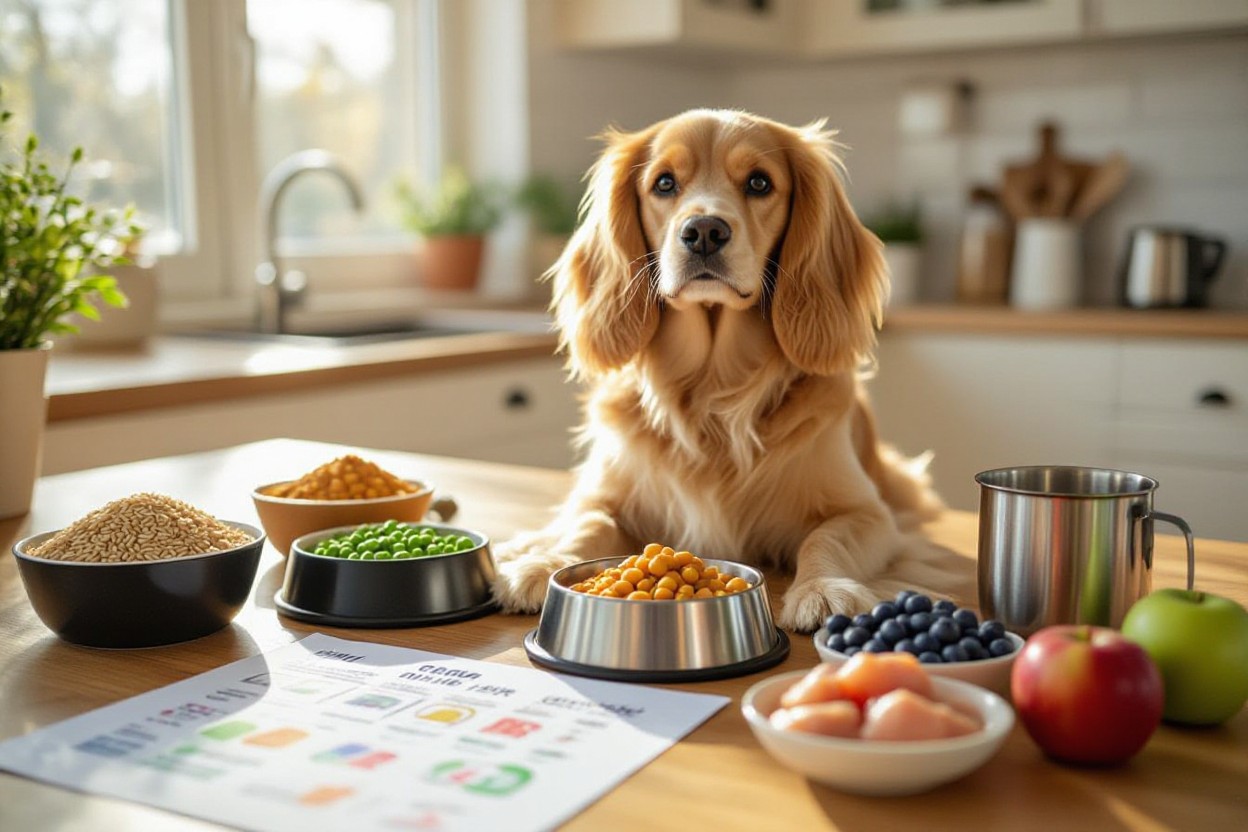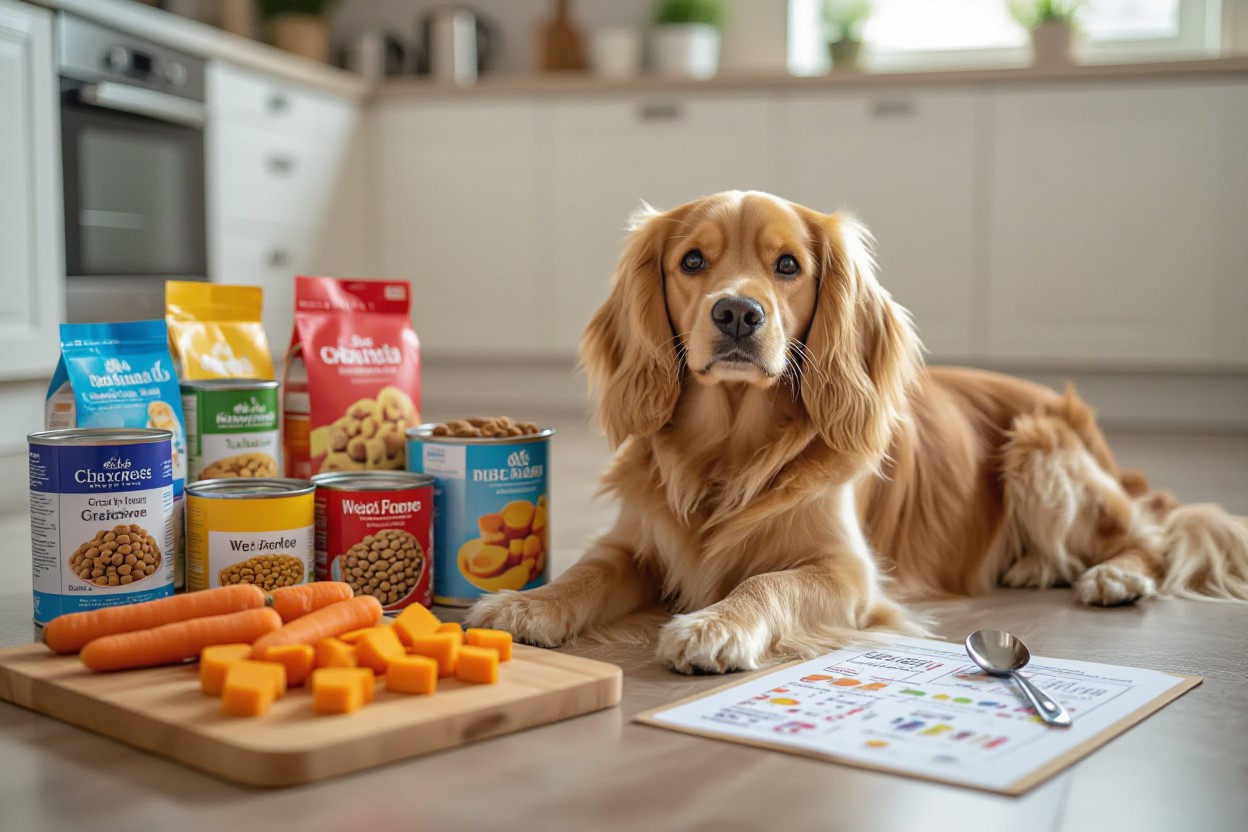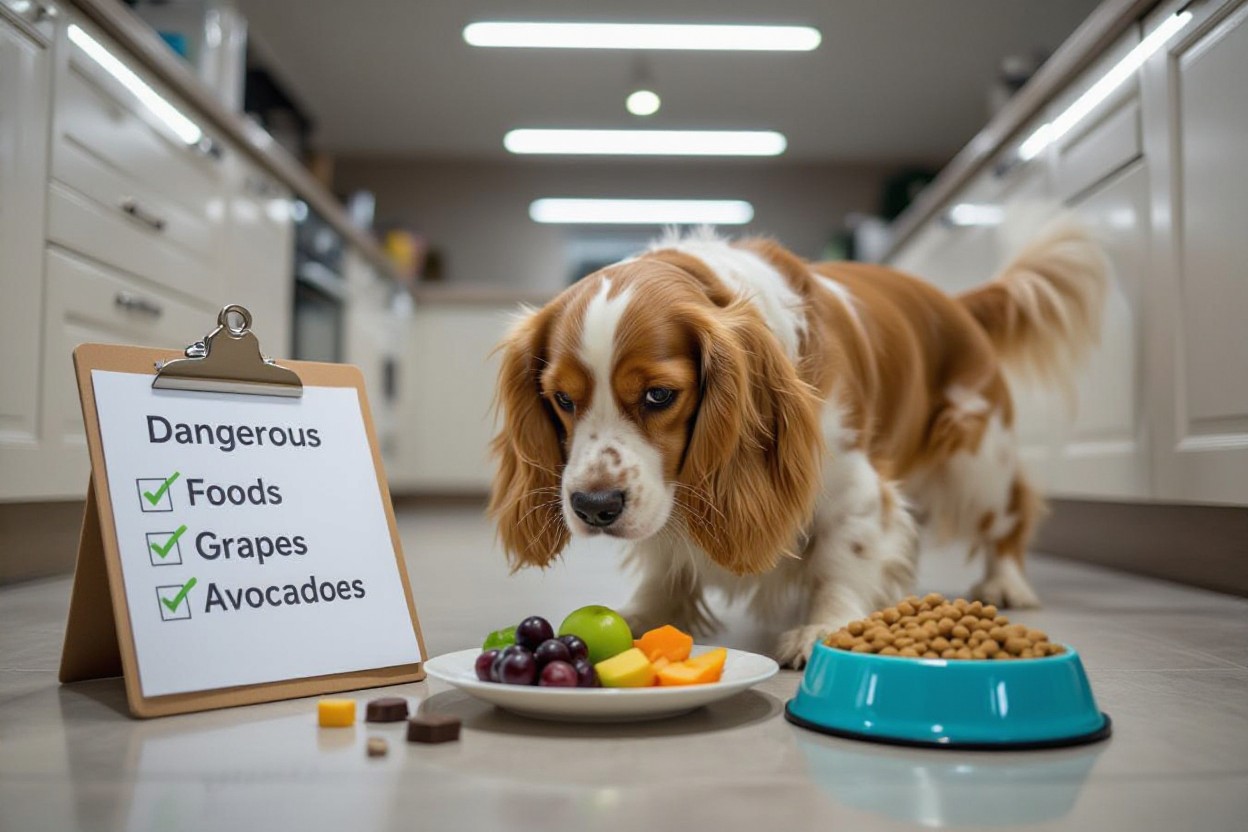Most Cocker Spaniel owners need clear advice on protein balance, weight control, and sensitive stomachs; in this feeding guide you’ll learn which protein levels and portion sizes suit Spaniels prone to obesity — for example my dog Milo stayed lean when switched to higher-protein dry kibble with controlled treats. This Spaniel nutrition overview covers dry vs wet food, safe home-cooked options, weight management tips, and foods to avoid like grapes, chocolate, and onions.
“Spaniel eating from bowl, natural light kitchen, cute healthy dog food scene.”
Essential Nutrients for Optimal Health
Your Cocker Spaniel thrives on balanced macronutrients plus targeted micronutrients: aim for 22–30% protein (dry matter) to support muscle and immune function, 8–15% healthy fats for coat and energy, and moderate, digestible carbs like sweet potato or brown rice to ease sensitive stomachs. For the best food for Cocker Spaniels choose formulas designed for weight control—Spaniels tend to gain weight—consider wet food for hydration or measured home‑cooked meals with vet guidance, and avoid toxic foods such as grapes, chocolate, and onions.
Key Macronutrients: Proteins, Fats, and Carbohydrates
High‑quality protein from chicken, fish, or turkey keeps your Spaniel lean and active; target 22–30% for adults and higher for growing pups. Fats supply energy and omega‑3s (EPA/DHA) that reduce ear inflammation and boost coat shine, while carbs should be low‑glycemic and fiber‑rich—pumpkin or brown rice help digestion. I switched my dog Bella to a moderate‑fat, higher‑protein kibble and safely lost two pounds; in your feeding guide, adjust portions when using wet food since calorie density differs.
Importance of Vitamins and Minerals in Cocker Spaniel Diet
Vitamins A, D, E and B‑complex support vision, bone health and metabolism, while minerals like calcium, phosphorus (aim for a Ca:P ratio near 1.1–1.4:1), zinc and iron keep skin, coat and immunity strong. Home‑cooked meals often lack balanced micronutrients unless you add a vet‑approved supplement; when I prepared meals for my dog Max I used a vet‑recommended multivitamin to prevent deficiencies and maintain energy for daily walks, reinforcing good Spaniel nutrition.
Fat‑soluble vitamins and trace minerals require careful balance: excess vitamin D or unbalanced calcium can harm growing pups, so rely on AAFCO‑balanced commercial diets or veterinary advice before supplementing. Practical steps include adding ~250–500 mg combined EPA+DHA daily for a 25‑lb Spaniel (adjust by weight after vet consultation), using pumpkin for fiber and gut health, and testing for zinc deficiency if ears stay flaky—my dog Luna’s coat improved after targeted supplementation.
“Spaniel eating from bowl, natural light kitchen, cute healthy dog food scene.”
Dry Food vs. Wet Food: The Nutritional Showdown
Benefits and Drawbacks of Dry Kibble
Dry kibble provides convenience, cost-efficiency, and typically 6–10% moisture with protein targets you should look for around 22–26% to support lean muscle in Spaniels. Expect roughly 350–450 kcal per cup, so measuring is key for obesity-prone Cocker Spaniels; a 25 lb Spaniel usually needs about 20–30 kcal per pound (500–750 kcal/day). Kibble can help reduce tartar, but some formulas include fillers or high fat that encourage weight gain—your Spaniel may do best on a measured, high‑protein, moderate‑fat formula.
The Appeal and Challenges of Wet Food Options
Wet food’s 70–80% moisture boosts hydration and palatability, useful for picky eaters or dogs with sensitive stomachs, and single‑ingredient pates can ease food sensitivities. Many cans contain 300–450 kcal, so portion control matters—your Spaniel can gain weight quickly if you don’t reduce kibble accordingly. Wet diets cost more, offer minimal dental benefit, and require refrigeration; try mixing a few tablespoons with kibble to increase acceptance without overfeeding.
Veterinary wet diets often use novel proteins (duck, venison) or limited ingredients and can calm GI upset within 1–2 weeks; transition over 7–10 days to avoid diarrhea. For weight management, calculate needs (20–30 kcal/lb) and measure combined wet+kibble calories; add pumpkin or probiotics for sensitive stomachs and avoid toxic foods like grapes, chocolate, and onions. If my own Spaniel reacted well to a duck‑based wet formula, yours might too—test single changes and track weight weekly.
“Spaniel eating from bowl, natural light kitchen, cute healthy dog food scene.”
Addressing Common Health Issues Through Diet
Tailor meals to the specific issues you see: aim for 22–28% protein and 10–15% fat on a dry-matter basis to support coat and muscle while keeping calories near 25–30 kcal per pound to prevent weight gain. Choose digestible proteins like turkey or fish for sensitive stomachs, prefer a balanced dry/wet mix or probiotic-fortified kibble, and avoid toxic foods such as grapes, chocolate, and onions to protect overall Spaniel nutrition and follow this feeding guide.
Weight Management and its Dietary Implications
Cocker Spaniels tend to pack on pounds, so you must weigh portions and track calories: target roughly 25 kcal per pound adjusted for activity, select higher-protein (22–26%) formulas with added fiber for satiety, and cap treats under 10% of daily calories. Measure food instead of free-feeding; when I shifted my dog to 1¼ cups of measured high-protein kibble and daily 20-minute walks, he dropped from 32 to 28 pounds in eight weeks.
Food Allergies and Sensitivities: Identifying Triggers
Frequent offenders include beef, dairy, chicken, wheat, and soy, often causing itchy skin, recurrent ear infections, or chronic diarrhea. Use a 6–8 week elimination with a novel protein (venison, rabbit) or hydrolyzed diet and log symptoms. Reintroduce one ingredient every 10–14 days to spot reactions. My dog reacted to chicken but improved on turkey and sweet potato, with ear inflammation clearing within three weeks.
Switch gradually over 7–10 days when starting an elimination diet, mixing increasing amounts until fully transitioned, and keep a food diary noting stool quality, scratching, and ear odor. Add a vet-recommended probiotic and plain canned pumpkin for gentle fiber, and consult your vet about allergy testing if reactions persist. During re-challenge, introduce single ingredients and observe for up to two weeks to confirm triggers so you can choose the best food for Cocker Spaniels with sensitive systems.
“Spaniel eating from bowl, natural light kitchen, cute healthy dog food scene.”
Crafting the Perfect Feeding Schedule
Set a consistent routine that matches your Spaniel’s activity and digestion: most adult Cocker Spaniels do best on two measured meals daily to prevent grazing-driven obesity, while puppies need three to four smaller feedings. Feed at fixed times, note how your dog’s energy and stool respond, and adjust portion size rather than adding extra meals. In my experience, switching my dog to 7:00 AM and 6:00 PM meals stopped late-night begging and helped steady his weight.
Ideal Portion Sizes for Your Cocker Spaniel
For an adult Cocker Spaniel weighing 20–30 lb, aim for roughly 600–900 kcal/day depending on activity and metabolism; puppies require higher calories per pound. Always use the kcal/cup on your food label to calculate portions—if your kibble is 360 kcal/cup and your target is 900 kcal/day, that’s about 2.5 cups daily split into two meals. Monitor body condition score, check ribs and waist, and tweak portions to prevent obesity while meeting protein needs for lean mass.
Timing and Frequency: Establishing Healthy Routines
Most adult Spaniels thrive on two feedings spaced 8–12 hours apart to stabilize blood sugar and reduce begging; schedule meals around walks and avoid vigorous exercise for 30–60 minutes after eating to lower bloat risk. Puppies should eat 3–4 times daily with gradual transitions. Keep treats under 10% of daily calories and never offer grapes, chocolate, or onions.
Practical schedules work: breakfast at 7:00 AM, short walk, play, then dinner around 6:00 PM with a calmer 20–30 minute walk afterward. For seniors or dogs on weight-loss plans, reduce daily calories by 10–20% and increase low-calorie, high-fiber veggies or specialized weight-control diets; my dog dropped a pound in four weeks after I cut treats, measured meals, and added 15 extra minutes of daily walking. Consult your vet to fine-tune timing and calories for activity level and any sensitive-stomach needs.
AI image prompt: “Spaniel eating from bowl, natural light kitchen, cute healthy dog food scene.”
Dangerous Foods: What to Keep Off the Menu
Given your Cocker Spaniel’s tendency toward weight gain and sensitive stomach, avoid foods that cause acute toxicity or chronic damage: grapes and raisins, chocolate, onions, high-fat scraps, and anything with xylitol. These items can provoke kidney injury, hemolytic anemia, pancreatitis, or severe hypoglycemia. Stick to vetted commercial diets or carefully balanced home-cooked recipes from your feeding guide to protect Spaniel nutrition and help maintain a healthy weight.
Toxic Foods That Could Harm Your Cocker Spaniel
Grapes/raisins have been tied to acute kidney failure—cases exist where a single grape caused illness—while chocolate (dark and baking chocolate highest) delivers theobromine that can trigger vomiting, tremors, and tachycardia. Onions, garlic, and leeks in any form can destroy red blood cells and lead to anemia; my Cocker once ate an onion ring and needed a vet check for anemia and GI upset. If your dog samples these, seek veterinary advice immediately.
Lesser-Known Foods to Avoid for Optimal Health
Xylitol (found in sugar-free gum, some peanut butters, and baked goods) causes rapid hypoglycemia and liver damage even in small amounts. Macadamia nuts induce weakness and ataxia; raw dough can expand and produce alcohol; cooked bones splinter and obstruct; fatty table scraps can spark pancreatitis. For Spaniel nutrition and the best food for Cocker Spaniels, prioritize low-fat, balanced options and avoid risky treats.
Pay attention to labels and storage: many peanut butters now contain xylitol—check ingredients before giving any to your dog. Bones from cooked meat and rich leftovers sent my dog to the ER once with pancreatitis, so you should avoid high-fat foods entirely and choose measured, vet-approved treats instead. Following this feeding guide level of caution helps control weight and protects your Cocker’s sensitive digestion.
“Spaniel eating from bowl, natural light kitchen, cute healthy dog food scene.”
Conclusion
The best food for Cocker Spaniels combines lean, high-quality protein, controlled calories and fiber to manage weight and support coat health; in your feeding guide aim for measured portions of premium dry kibble with occasional wet-food toppers or vet-approved home-cooked meals. If your dog has a sensitive stomach, try gradual transitions and limited-ingredient diets—for example, when your dog experienced upset, switching to chicken and rice eased symptoms. Avoid toxic foods like grapes, chocolate and onions and consult your vet for Spaniel nutrition tailored to your dog.
“Spaniel eating from bowl, natural light kitchen, cute healthy dog food scene.”


